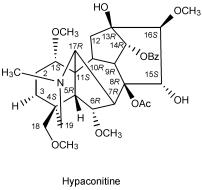| [1] |
陈玉宛, 周雯, 李欣蔚, 杨开广, 梁振, 张丽华, 张玉奎. 基于液质联用技术的蛋白质-蛋白质相互作用研究进展※[J]. 化学学报, 2022, 80(6): 817-826. |
| [2] |
李飞, 王宇光, 杨亮, 朱冠秀, 梁乾德, 马增春, 肖成荣, 谭洪玲, 汤响林, 高月. UPLC-Q-TOF/MS分析不同比例丹参配伍藜芦毒性生物碱变化规律[J]. 化学学报, 2012, 70(21): 2257-2264. |
| [3] |
朱粉霞, 赵永刚, 贾晓斌, 韦英杰, 张振海, 古丽娜尔·吾拉孜汗. 淫羊藿炮制前后UPLC-PDA-MS 的指纹图谱研究[J]. 化学学报, 2012, 70(05): 635-642 . |
| [4] |
辛杨, 皮子凤, 宋凤瑞, 刘志强, 刘淑莹. 利用液质联用技术分析干姜对乌头类生物碱在大鼠肠内吸收的影响[J]. 化学学报, 2012, 70(05): 551-560 . |
| [5] |
周思思, 马增春, 梁乾德, 王宇光, 谭洪玲, 肖成荣, 张伯礼, 高月. 基于UPLC/Q-TOF-MS 分析附子半夏配伍相反的物质基础[J]. 化学学报, 2012, 70(03): 284-290. |
| [6] |
刘璐莎, 樊君, 胡春梅, 孙洋, 胡晓云, 赵英永, 魏嵩, 梁旭华. 土贝母皂苷II与人血清白蛋白相互作用机制的光谱研究[J]. 化学学报, 2011, 69(21): 2589-2596. |
| [7] |
韩天娇, 宋凤瑞, 刘忠英, 皮子凤, 刘志强, 刘淑莹. 附子配伍过程中二萜类生物碱在Caco-2小肠吸收细胞模型中吸收转运的UPLC/MS研究[J]. 化学学报, 2011, 69(15): 1795-1802. |
| [8] |
刘文龙, 宋凤瑞, 刘志强, 刘淑莹, 张大方. 川乌与半夏、瓜蒌、贝母、白蔹、白芨配伍禁忌的化学研究[J]. 化学学报, 2010, 68(9): 889-896. |
| [9] |
随志刚, 姜雅秋, 刘志强, 梁峰, 闫峻, 刘忠英. 乌头碱在家兔肠道内代谢产物的LC/ESI-MSn研究[J]. 化学学报, 2009, 67(21): 2439-2444. |
| [10] |
赵宇峰,宋凤瑞,王曦烨,国新华,刘志强,刘淑莹. 16-O-去甲基乌头碱的生物转化及电喷雾质谱研究[J]. 化学学报, 2008, 66(5): 525-530. |
| [11] |
周莉莉,刘志强,吴国光,宋凤瑞,刘淑莹. 山茱萸炮制过程中环烯醚萜苷类成分的质谱研究[J]. 化学学报, 2008, 66(24): 2712-2716. |
| [12] |
越皓,皮子凤,宋凤瑞,刘志强,刘淑莹. 生附片化学成分的HPLC/ESI-MSn研究[J]. 化学学报, 2008, 66(2): 211-215. |
| [13] |
张旭, 宋凤瑞, 王隶书, 刘志强, 刘淑莹. 人参与藜芦配伍化学成分变化的HPLC-ESI-MS与ESI-MS研究[J]. 化学学报, 2007, 65(9): 829-833. |
| [14] |
陈东林,简锡贤,陈巧鸿,王锋鹏. 直缘乌头中新的C19—二萜生物碱的结构研究[J]. 化学学报, 2003, 61(6): 901-906. |
| [15] |
王锋鹏,李正邦,王建忠,简锡贤,陈东林. 膝瓣乌头根中新去甲二萜生物碱的结构研究[J]. 化学学报, 2000, 58(5): 576-579. |
